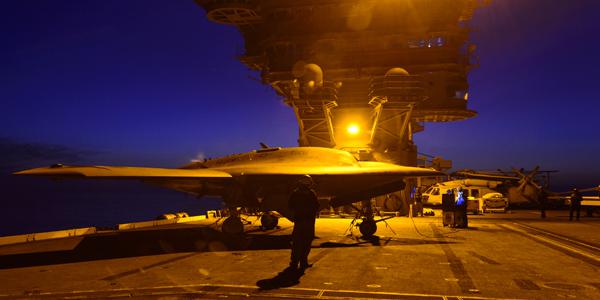PEO Spotlight: Improving the Flow From Sensors to Unmanned Vehicles
The U.S. Navy’s Program Executive Office (PEO) for Unmanned Aviation and Strike Weapons is striving for better integration of sensors and weapon systems across the entire domain. This entails smoothing the way for upgrades by standardizing equipment from sensors to platforms.
Rear Adm. (S) Mark W. Darrah, USN, is the PEO for Unmanned Aviation and Strike Weapons. Adm. Darrah comes from the electronic attack community, including an aviation command tour, before he entered the acquisition world more than a decade ago. He has held positions in the EA-18G Growler, the F/A-18 and the Joint Strike Fighter programs. The admiral has been in his current PEO position for six months.
Kill chain gaps are a key focus for the office. Adm. Darrah notes it is analyzing the portions of the kill chain that are not tied together as well as they could be. This largely is a function of networks and standards, which are the key to upgrades, he warrants. “All the upgrades we are looking for have to do with affordably integrating new capability to fill gaps that are identified by our kill chain analysis,” he declares.
Among specific technologies, the admiral says his office is focused on precise navigation in denied environments. This capability would permit the Navy to operate its systems in a precise manner if the Global Positioning System were unavailable, he allows.
Another, more difficult, technology goal is to unlock untapped capabilities inherent in current systems, Adm. Darrah offers. For example, the APG-79 active electronically scanned array (AESA) radar that is on the F/A-18E and EA-18G is capable of doing more than its current processors can manage. The Navy needs to be able to draw out that inherent capability through either connecting with another system or improving internal processing.
All-domain access is another function the office is addressing. The Navy must be able to operate on the surface, underwater, in the air or in space, the admiral points out, adding that it also must be able to upgrade systems that operate across multiple domains. “We want things that will fit within our current architectures that won’t require us to change [the architectures],” he says.
The admiral continues that this is taking place in targeted areas, but the Navy is not yet able to achieve this across the entire enterprise. Existing budget items aim at this goal, and it may be achieved over the next five years, he offers.
Cybersecurity looms large in all aspects of the defense community, and the admiral’s office is no exception. “We’re trying to understand what we need to do with our weapon systems with regard to the cybersecurity challenges that we’re seeing out there,” he allows. “People normally think about cybersecurity from a business system perspective—the networks, for example. These aircraft and weapons that we operate are not business systems. What we see as our technical challenge is what we do to our current platforms, sensors and weapons to ensure they are able to operate in a robust cyberwarfare environment?”
Understanding the cyberthreat is the key to addressing that challenge, Adm. Darrah continues, but that threat is constantly changing. Systems must have the flexibility and adaptability to manage this ever-changing threat. This issue has come up with every technology advance in naval history, he points out, and the Navy will figure out how to respond as it has done over the years.
Adm. Darrah emphasizes that industry must work with the Navy to build systems that are platform agnostic. The Navy must be able to integrate new weapons or sensors into manned or unmanned systems without going through the pain and cost of integrating a unique configuration. This thrust comes top-down from the chief of naval operations, the admiral observes, with an increased focus on sensors and the data they produce. “Industry needs to help us to stop tailoring our payloads to the platform and focus more on the sensor itself—and do a better job of getting full performance for that sensor, whether we put it on a platform or on a weapon,” he says.
Bringing small businesses into the effort is one of the admiral’s priorities, he offers, for “the innovation, the agility and the affordability they can bring.” He explains this entails understanding which small businesses currently are supporting the office’s prime contractors and whether the primes are leveraging them properly. The office has just designated all of its deputy program managers as small business advocates within each program.
The office also is sponsoring industry days—one of which just took place—in which the majority of participants are small businesses. At the most recent event, the office explained the current threat environment in an unclassified format, described the office’s challenges, outlined the kill chain gaps and then offered where industry could provide the best products for attaining its goal.
Adm. Darrah adds that he needs to work with the Naval Air Systems Command because it has access to small businesses working with the warfare centers. The admiral allows that he does not always attain access to these contracts, and he wants to open channels into this area.
Above all, the admiral’s top priority is to deliver products to the fleet on time and affordably, he declares. “We have good plans; we just have to execute and deliver.” The uncertainty of the environment has generated huge challenges at the program level in trying to execute a plan when each year may bring budget-inspired changes, he allows.





Comment
DON
Good Rticle about DONs outlook
Comments